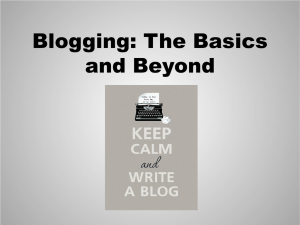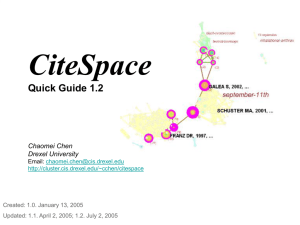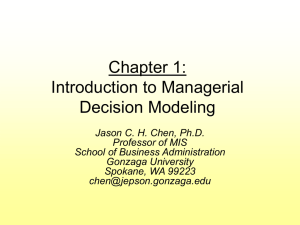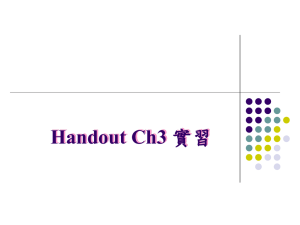基础研究论文
advertisement
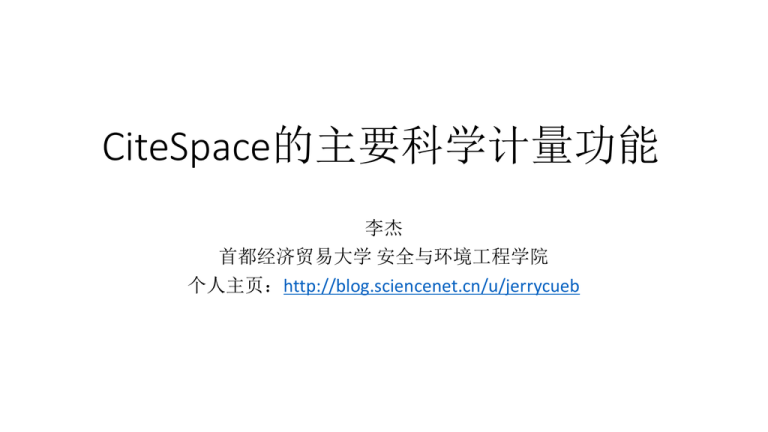
CiteSpace的主要科学计量功能 李杰 首都经济贸易大学 安全与环境工程学院 个人主页:http://blog.sciencenet.cn/u/jerrycueb 写在前面 • 有关CiteSpace的经典文献和实例文献 • 基础研究论文 1. Chen, C. (2004) Searching for intellectual turning points: Progressive Knowledge Domain Visualization.Proceedings of the National Academy of Sciences of the United States of America (PNAS), 101 (Suppl. 1), 5303-5310. 2. Chen, C. (2006) CiteSpace II: Detecting and visualizing emerging trends and transient patterns in scientific literature. Journal of the American Society for Information Science and Technology, 57(3), 359-377. 《中译本》 3. Chen, C. et al. (2010) The structure and dynamics of co-citation clusters: A multiple-perspective co-citation analysis. Journal of the American Society for Information Science and Technology. (10.1002/asi.21309) • 近期很有学习意义的实例论文 1. Chen, C., Dubin, R., & Kim, M. C. (2014). Emerging trends and new developments in regenerative medicine: a scientometric update (2000-2014).Expert opinion on biological therapy, 14(9), 1295-1317. http://informahealthcare.com/doi/pdf/10.1517/14712598.2014.920813 2. Chen C, Dubin R, Kim M C. Orphan drugs and rare diseases: a scientometric review (2000-2014)[J]. Expert Opinion on Orphan Drugs, 2014 (0): 1-16. http://www.researchgate.net/profile/Chaomei_Chen 有关CiteSpace的论文 1. http://scholar.google.com/scholar?hl=en&q=CiteSpace&btnG=&as_sdt=1%2C5 &as_sdtp= 2. 学习科学计量分析的推荐论文 ① Peters, H. P., & Van Raan, A. F. (1991). Structuring scientific activities by co-author analysis. Scientometrics, 20(1), 235255. ② White, H. D., & McCain, K. W. (1998). Visualizing a discipline: An author co-citation analysis of information science, 19721995. Journal of the American Society for information science, 49(4), 327-355. ③ Culnan, M. J. (1987). Mapping the intellectual structure of MIS, 1980-1985: a co-citation analysis. Mis Quarterly, 341-353. ④ Kessler, M. M. (1963). Bibliographic coupling between scientific papers.American documentation, 14(1), 10-25. ⑤ Boyack, K. W., & Klavans, R. (2010). Co‐citation analysis, bibliographic coupling, and direct citation: Which citation approach represents the research front most accurately?. Journal of the American Society for Information Science and Technology, 61(12), 2389-2404. 主要功能总述 节点类型决定了使用CiteSpace分析的目的 作者、机构或者国家的合作网络分析 主题、关键词或WoS分类的共现分析 文献的共被引分析、作者的共被引分析以及期刊的共被引分析 文献的耦合分析 合作网络分析举例 作者、机构或者国家的合作网络分析,在 网中节点的大小反映的是作者、国家/地 区或者机构的发文量。 国家-地区合作网络 作者合作网络 数据来源参见: http://cluster.ischool.drexel.edu/~cchen /citespace/doc/tutorial/how_to/1.dow nload_from_WOS.pdf 机构合作网络 主题、关键词或WoS分类的共现分析 主题、关键词或WoS分类的共现分析 ,节点大小反映的是主题、关键词或者 领域的频次。 关键词共现分析 主题共现分析 数据来源参见: http://blog.sciencenet.cn/blog-554179831518.html 领域共现分析 共被引分析 文献的共被引分析、作者的共被引分析以及期刊的共被引分析, 节点的大小代表文献、期刊或者作者的被引次数,连线的颜色 代表首次共被引的时间。 文献共被引分析 期刊共被引分析 作者共被引分析 数据来源参见:http://blog.sciencenet.cn/blog-554179-831518.html 文献的耦合分析 文献的耦合分析 数据来源参见: http://blog.sciencenet.cn/blog -554179-831518.html 文献的耦合分析 推荐的免费获取学习资料 1. 如何使用CiteSpace的几个示范. http://blog.sciencenet.cn/blog-496649-838067.html 2. Chen, C. (2014) The CiteSpace Manual. http://cluster.ischool.drexel.edu/~cchen/citespace/CiteSpaceManual.pdf 3. CiteSpace重要问题整理. http://blog.sciencenet.cn/blog-554179-667300.html



